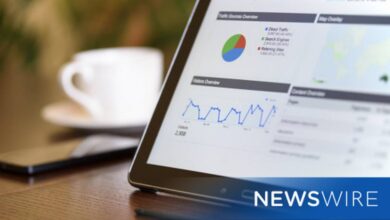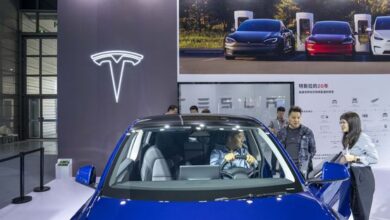EV transition cools as demand slows and automakers trim production

“Automakers have moved from rosy to reality because consumer acceptance has grown more slowly. So they are looking at kind of slowing their rollout,” said Michelle Krebs, an industry analyst with Cox Automotive. The transition to EVs is “not going to be linear and there are going to be a lot of bumps in the road,” she added.
There were 869,000 fully electric vehicles sold in the United States in the first 10 months of this year, a 56 percent increase over the same period in 2022, according to data provider J.D. Power. That growth rate marked a slowdown from two years earlier, and was lower than what some automakers had forecast.
“The narrative has taken over that EVs aren’t growing. They’re growing,” Ford Chief Financial Officer John Lawler said in October. “It’s just growing at a slower pace than the industry and quite frankly, we, expected.”
The Biden administration has said it wants half of all new-vehicle sales by 2030 to be zero-emissions vehicles, which it defines as fully electric vehicles and plug-in hybrids. As of last month, those models made up 10.8 percent of new vehicle sales in the United States, with the bulk being fully electric, according to J.D. Power.
EV experts say it’s still possible to reach the White House’s target if consumers see progress soon on charging availability — something that should happen as federally subsidized chargers start to appear in the coming months. Mark Z. Jacobson, a renewable-energy expert and engineering professor at Stanford University, said buyers also need more information about the cost savings of going electric.
“Given that driving an electric vehicle saves the average driver about $20,000-$30,000 over 15 years in fuel cost savings alone, I think the only thing holding back consumer demand is a lack of information about this,” he said.
The Biden administration says EV sales have tripled since President Biden took office, and points to research showing that 51 percent of surveyed Americans this year were considering an EV, up from 38 percent two years earlier. With the help of federal subsidies, the nation is on pace to add 500,000 new chargers by 2026, administration officials say.
“More Americans are buying EVs every day — with EV sales rising faster than traditional gas-powered cars — as the President’s Investing in America agenda makes EVs more affordable, helps Americans save money when driving, and makes EV charging accessible and convenient,” White House spokesman Angelo Fernandez Hernandez said in a statement.
Yet Ford and General Motors are among the automakers that have trimmed EV production and postponed investments in recent weeks amid cooling sales.
GM in October said “slowing near-term growth” was prompting the company to scrap its target to build 400,000 EVs by the middle of next year and delay the start of EV truck production at a factory in Lake Orion, Mich. GM added that it will keep its manufacturing flexible to produce gas-powered or electric vehicles, depending on demand.
Mary Barra, CEO of GM, last month stressed the need for a more robust charging network to overcome consumer concerns. Surveys by J.D. Power have shown drivers are frustrated by a lack of chargers and by frequently broken stations. About 1 in 5 charging attempts fail, and about 1 in 3 EV shoppers don’t have access to home charging, according to Elizabeth Krear, an EV expert at J.D. Power.
Ford in October said it would cut production of its electric Mustang Mach-E and delay $12 billion of investments in battery factories and other EV initiatives. Ford has also said it will put more emphasis on producing hybrid vehicles, calling them a “bridge” to the fully EV market.
In recent weeks, Ford told its suppliers that it is halving its 2024 production plan for the electric F-150 Lightning pickup, to about 1,600 a week, Automotive News reported this month. A Ford spokesman declined to comment on the report, beyond saying that the company will “continue to match production to demand.”
Even Tesla, which dominates EV sales in the United States, has slowed plans to open a new factory in Mexico that will supply the North American market, though it blamed high interest rates rather than anything specific to EVs.
“I think we want to just get a sense for what the global economy is like before we go full tilt on the Mexico factory. I am worried about the high interest rate environment that we’re in,” Tesla CEO Elon Musk told investors in October. “I just can’t emphasize this enough, that [for] the vast majority of people buying a car is about the monthly payment.”
Cooling demand and growing competition has led to more EV price cutting, helping narrow the price gap between EVs and gasoline-powered cars. The average U.S. price paid for a new EV in November was $52,345, about 8.5 percent higher than the average price for the total market, according to Cox Automotive. A year ago, the EV premium was more than 30 percent.
Improving the sparse and often faulty public charging network is vital to broadening the EV market beyond tech-savvy, upper-income buyers to include more middle-income Americans unwilling to tolerate inconvenience just for the sake of going electric, experts say.
Early adopters are “very accepting of faults in new technology,” said Nick Nigro, founder of Atlas Public Policy, which conducts research on climate and tech issues. “Everyday people aren’t like that. If the charger doesn’t work when you plug in, even if the issue is just you have to try again, that’s not going to work.”
The bipartisan infrastructure law, which Biden signed two years ago, provided $7.5 billion to state and local governments over five years to subsidize charger construction, a campaign that is only now beginning to lead to the opening of new charging stations.
Sam Abuelsamid, a charging expert at market intelligence firm Guidehouse Insights, said it has taken this long because charging providers have to jump through many hoops to build a station, including working with local utilities to secure power, receiving permits, and buying and installing hardware.
“Given the amount of time it takes to deploy a DC charging station I’m not at all surprised that we are only getting the first ones now,” he said.
For now, the U.S. network relies heavily on Tesla. There are about 35,000 public fast-charging ports in the United States, about tw0-thirds of which belong to Tesla, according to Atlas Public Policy.
GM, Honda, Hyundai and several other automakers this summer said they are banding together to significantly expand the fast-charging network by installing 30,000 new chargers in North America. The first stations are expected next summer.
“I think for years the auto companies have defined their product as the car … and it’s up to different providers to service those cars, to fuel those cars,” Jon McNeill, a GM board member and a former top executive at Tesla, said in an interview. “It’s taken time for manufacturers to understand … that the product isn’t just the car, it’s the experience … it’s the charging experience, too.”





